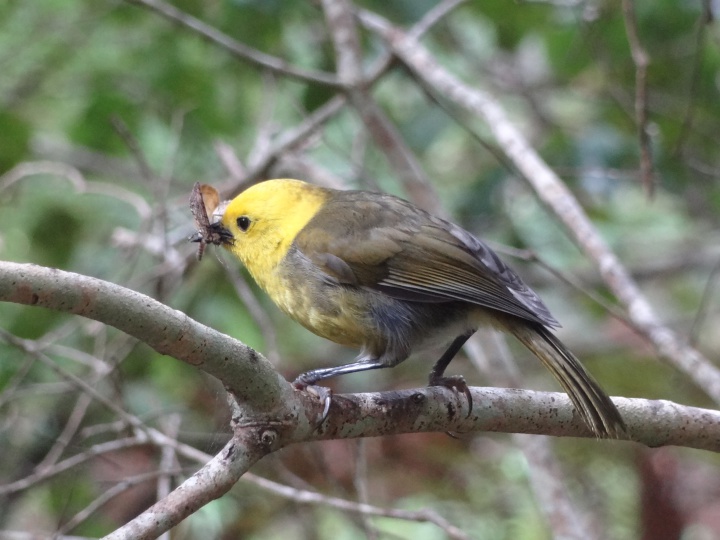Mohua goes from rare to common in 21 years
8 May 2019

The once rare mohua/yellowhead has for the first time become the most common native bird counted since predator control began in the Landsborough valley in South Westland.
Mohua numbers have risen more than 30-fold and overall, native bird numbers have doubled in the 21 years since monitoring began in 1998, recently analysed Department of Conservation (DOC) results show.
DOC Principal Science Advisor Dr Colin O’Donnell says the long-term study charts the response of 13 native bird species following sustained predator control to suppress rats, stoats and possums.
“Our most recent bird count data from last spring shows seven native bird species are still increasing in numbers, four species remain stable, and two have declined.”
“For the first time in 21 years, mohua have become the most common bird counted, which is what they would have been in this valley prior to European settlement.”
“The results are exciting because year by year we’re seeing a re-balance of the valley’s birdlife and don’t know when population limits will be reached,” says Dr O’Donnell.
Numbers of mohua/yellowhead, tuī, bellbird/korimako, brown creeper/pīpipi, rifleman/tītitipounamu, grey warbler/riroriro andkākāriki/yellow-crowned parakeet have all steadily increased over the last 21 years.
Mohua have gone from just 14 birds to 444 counted in the study area last November.
Kākā, tomtit/ngirungiru, fantail/pīwakawaka and kererū/wood pigeon have remained stable and not declined as they would have been expected to without predator control.
Two species, tautou/silvereye and the migratory long-tailed cuckoo/koekoeā, have declined. For silvereye this could be due to greater competition for nectar from the more aggressive tuī and bellbird.
Long-tailed cuckoo migrates to the Pacific islands each winter and may be being affected by conditions there. It returns to lay its eggs in mohua and brown creeper nests in late spring.
Predator control began in the Landsborough valley in 1994 after the impact of predators on birdlife was observed. Since then, DOC has done valley-wide trapping, and six aerial-1080 operations timed to suppress increasing rodent levels, with the most recent two, in 2014 and 2016, covering the entire valley.
Due to this year’s heavy beech mast the Landsborough is a priority for aerial-1080 predator control. This will take place as part of DOC’s Tiakina Ngā Manu, formally Battle for our Birds programme, which aims to protect vulnerable ecosystems and wildlife at important sites throughout New Zealand.
–Ends–


 Waipa Networks: Cambridge Is Open For Business With $45M Energy Boost
Waipa Networks: Cambridge Is Open For Business With $45M Energy Boost Master Plumbers Gasfitters and Drainlayers NZ: New Consumer NZ Test Reveals Danger Of Unregulated Online Plumbing Products
Master Plumbers Gasfitters and Drainlayers NZ: New Consumer NZ Test Reveals Danger Of Unregulated Online Plumbing Products Mindful Money: Winners At The Mindful Money Annual Ethical & Impact Investment Awards 2025
Mindful Money: Winners At The Mindful Money Annual Ethical & Impact Investment Awards 2025 MBIE: Gas Supply Reducing Faster And Sooner Than Previously Forecast
MBIE: Gas Supply Reducing Faster And Sooner Than Previously Forecast Natural Hazards Commission: International Markets Show Unprecedented Confidence In NZ’s Natural Hazards Insurance Scheme
Natural Hazards Commission: International Markets Show Unprecedented Confidence In NZ’s Natural Hazards Insurance Scheme  ASB Bank: ASB Business Survey - The Impact Of Trump's Tariffs, According To Kiwi Businesses
ASB Bank: ASB Business Survey - The Impact Of Trump's Tariffs, According To Kiwi Businesses


